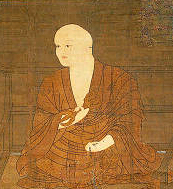Kūkai
Jump to navigation
Jump to search
| English Phonetics | Kūkai |
|---|
Alternate names
- Kōbō Daishi (Great Master Who Spread the Dharma)
Dates
| Birth: | 774 |
|---|---|
| Death: | 835 |
| Place of birth: | Sanuki Province, Shikoku Island, Japan |
Tibetan calendar dates
About
- Religious Affiliation
- Shingon school
Other Biographical info:
Links
- Wiki Pages
Buddha Nature Project
- Person description or short bio
- In Japanese, “Sea of Emptiness”; monk who is considered the founder of the tradition, often referred to as the Shingonshū, Tōmitsu, or simply mikkyō. He is often known by his posthumous title Kōbō Daishi, or "Great Master Who Spread the Dharma," which was granted to him by Emperor Daigo in 921. A native of Sanuki province on the island of Shikoku, Kūkai came from a prominent local family. At the age of fifteen, he was sent to Nara, where he studied the Chinese classics and was preparing to become a government official. However, he seems to have grown disillusioned with this life. At the age of twenty, Kūkai was ordained, perhaps by the priest Gonsō, and the following year he took the full precepts at Tōdaiji. He is claimed to have experienced an awakening while performing the Kokūzō gumonjihō, a ritual dedicated to the mantra of the bodhisattva Ākāśagarbha. While studying Buddhist texts on his own, Kūkai is said to have encountered the Mahāvairocanābhisaṃbodhiūtra and, unable to find a master who could teach him to read its mantras, decided to travel to China to learn from masters there. In 804, he was selected as a member of a delegation to China that set sail in four ships; Saichō was aboard another of the ships. Kūkai eventually traveled to the Tang capital of Chang’an, where he studied tantric mijiao Buddhist rituals and theory under Huiguo and Sanskrit under the Indian monk Prajña. Under the direction of his Chinese master, Kūkai was initiated into the two realm (ryōbu) maṇḍala lineages of Yixing, Śubhakarasiṃha, Vajrabodhi, and Amoghavajra. In 806, Kūkai returned to Japan; records of the texts and implements he brought with him are preserved in the Shōrai mokuroku. Little is known about his activities until 809, when he moved to Mt. Takao by imperial request. Kūkai described his new teachings as mikkyō, or "secret teachings," vajrayāna ( J . kongōjō), and mantrayāna (J. shingonjō). At the core of Kūkai’s doctrinal and ritual program was the belief that all acts of body, speech, and mind are rooted in, and expressions of, the cosmic buddha Mahāvairocana, as the dharmakāya. Kūkai argued that the dharmakāya itself teaches through the artistic and ritual forms that he brought to Japan. Once his teachings gained some renown, Kūkai conducted several abhiṣeka ceremonies, including one for the Tendai patriarch Saichō and his disciples. However, Kūkai and Saichō’s relationship soured when Kūkai refused to transmit the highest level of initiation to Saichō. In 816, Emperor Saga granted Kūkai rights to Kōyasan, to serve as a training center for his Shingon mikkyō tradition. In early 823, Kūkai was granted the temple of Tōji in Kyōto, which became a second center for the Shingon tradition. In the summer of 825, Kūkai built a lecture hall at Tōji, and in 827 he was promoted to senior assistant high priest in the Bureau of Clergy. In 829, he built an abhiṣeka platform at Tōdaiji. In early 834, he received permission to establish a Shingon chapel within the imperial palace, where he constructed a maṇḍala altar. Kūkai passed into eternal samādhi (J. nyūjō) in 835 on Mt. Kōya, and it is said that he remains in his mausoleum in meditation waiting for the bodhisattva Maitreya to appear. Kūkai authored a number of important texts, including the Benkenmitsu nikyōron, a treatise outlining the inherent differences of kengyō (revealed) and mikkyō (inner) teachings; Sokushin jōbutsugi, a treatise on the doctrine of attainment of buddhahood in "this very body" (J. sokushin jōbutsu); Unjigi, a text describing the contemplation of Sanskrit syllables (S. bīja , J. shuji); Shōjijissōgi, a text outlining Kūkai's theory of language in which all sounds and letters are themselves full embodiments of the dharmakāya’s teachings; and his magnum opus, the Himitsu mandara jūjūshinron, in which Kūkai makes his case for recognizing Shingon mikkyō as the pinnacle of Buddhist wisdom. Kūkai was an accomplished calligrapher, poet, engineer, and sculptor and is also said to have invented kana, the Japanese syllabary (Source: "Kūkai." In The Princeton Dictionary of Buddhism, 450. Princeton University Press, 2014.)
Expand to see this person's philosophical positions on Buddha-nature.
| Is Buddha-nature considered definitive or provisional? | |
|---|---|
| Position: | |
| Notes: | |
| All beings have Buddha-nature | |
| Position: | |
| If "Qualified", explain: | |
| Notes: | |
| Which Wheel Turning | |
| Position: | |
| Notes: | |
| Yogācāra vs Madhyamaka | |
| Position: | |
| Notes: | |
| Zhentong vs Rangtong | |
| Position: | |
| Notes: | |
| Promotes how many vehicles? | |
| Position: | |
| Notes: | |
| Analytic vs Meditative Tradition | |
| Position: | |
| Notes: | |
| What is Buddha-nature? | |
| Position: | |
| Notes: | |
| Svātantrika (རང་རྒྱུད་) vs Prāsaṅgika (ཐལ་འགྱུར་པ་) | |
| Position: | |
| Notes: | |
| Causal nature of the vajrapāda | |
| Position: | |
